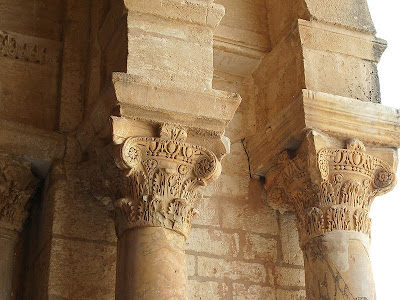The Mosque of Uqba (Arabic: جامع عقبة), also known as the Great Mosque of Kairouan (Arabic: جامع القيروان الأكبر), is one of the most important mosques in Tunisia.
Built by Uqba ibn Nafi from 670 A.D. (the year 50 according to the Islamic calendar) at the founding of the city of Kairouan, the mosque is spread over a surface area of 900 square metres and is considered as a model for all later mosques in the Maghreb in the western Islamic world.
Under the Aghlabids, the fame of the Mosque of Uqba and of the other holy sites at Kairouan helped the city to develop and repopulate little by little. The university, consisting of scholars who met in the mosque, was a centre of education both in Islamic thought and in the secular sciences. Its role can be compared to that of the University of Paris in the Middle Ages. With the decline of the city, the centre of intellectual thought moved to the University of Ez-Zitouna in Tunis.
Construction
The present form of the mosque dates back to the Aghlabid dynasty (with the exception of a few partial restorations and several later additions). Prior to this era, the mosque had been reconstructed several times following the successive invasions of Kairouan. With the exception of the mihrab, no part of the mosque is older than the 9th century.
Shortly after its construction, the mosque was destroyed during the occupation of Kairouan by the Berbers, led at first by Kusaila (around 690). The mosque was reconstructed by the Arab Emir Ben Noman around 10 years later. In light of Kairouan’s growing population, Hichâm ibn Abd al-Malik, the Umayyad Caliph of Damascus, ordered work to be undertaken in the city, which included the destruction of the mosque (with the exception of the mihrab) and its subsequent reconstruction.
Under the Aghlabids, Kairouan was at its apogee and the mosque profited from this period of calm and prosperity. In 836, Ziadet-Allah I reconstructed the mosque once more. In 863, Abou-Ibrahim increased the size of the oratory with the addition of three bays to the north, and added the cupola over the entry. In 875, Ibrahim II constructed another three bays, thereby reducing the size of the courtyard which was further limited on the three other sides by the addition of double galleries. After this date, the mosque did not undergo more than minor changes or restoration work.
Description
The Mosque of Uqba greatly resembles an imposing fortress, a consequence of the 1.9 metre thick stones that were used to build its walls and its ramparts, in addition to its towers and the solid buttresses that support and strengthen the walls. The mosque takes the form of an irregular quadrilateral, which is wider on the side of the main entrance (138 metres) than on the opposite side (128 metres) and thinner on the side of the minaret (71 metres) than on the opposite side (77 metres).
The courtyard is accessible via six lateral doorways and forms a rectangle (approximately 60 metres x 40 metres in size) surrounded by galleries supported by columns made variously of marble, granite or porphyry and which were taken from ancient monuments (primarily from Carthage), as were those in the prayer hall. Near to the centre of the courtyard, there is a rainwater collector, which filters the water before allowing it to pass into the cistern located underneath the courtyard, and a sundial.
The minaret, which serves both as a watchtower and to call the faithful to prayer, is made of three tiers with a total height of 31.5 metres, thereby dominating the mosque. It is built on a square base that is 10.5 metres long on each side. The minaret, which was begun by the Umayyad governor Bishr Ibn Safouan around 725 and completed by the Aghlabid princes in the 9th century, is the fourth oldest in the world.
The prayer hall, which is accessible via 14 doors, is divided into 17 naves and eight bays including more than 400 columns similar to those in the courtyard. The minbar, which dates to the 9th century, making it the oldest in the Islamic world, is made of around 300 pieces of sculpted teak. To the right of it is the 'maksoura, a beautiful separating barrier which allows dignitaries to be separated from other visitors.
A legend says that it is not possible to count the columns of the Mosque of Uqba without going blind.













































No comments:
Post a Comment